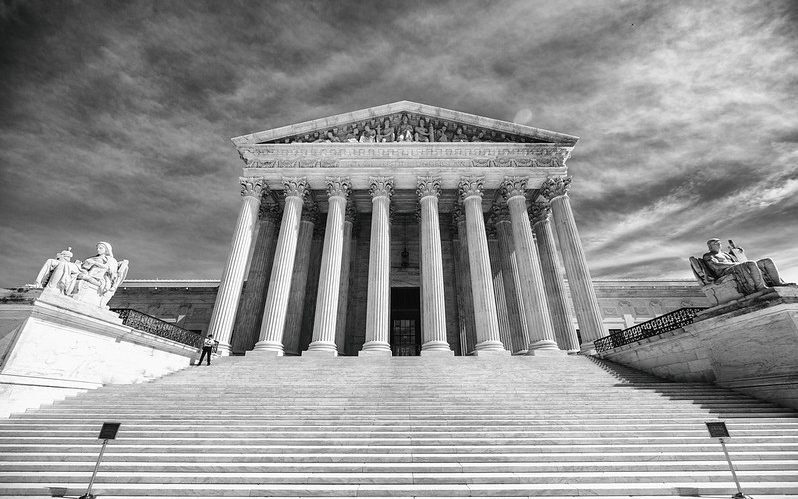America has long been held as a “beacon of democracy, liberty, and freedom”, a role model for other states to follow and aspire to. No more, some say.
Among the perhaps defining events leading to the country’s reputational damage was Donald Trump’s election as president in 2016 and the events that occurred during his presidency, but also after. One of the most memorable moments came at the end of his presidency when he lost the 2020 election to Joe Biden: the attack on the Capitol and the violence that ensued, which Trump himself, to a large part, incited by telling the public that he was the true winner of the election and urging them to “march to the Capitol”, the symbol for American democracy. The attack on the United States Capitol is currently the subject of investigation in the January 6 Committee hearings. What is clear for now is that, with the lies the former president spread and the violence he incited, he almost managed to overthrow American democracy, thereby also changing the public’s perception of the United States’ democratic resilience.
But not only that. Trump’s presidency has long-lasting consequences on the American political and legal landscape which perhaps only now begin to transpire. During his time in office, Trump had the (unlucky) opportunity to nominate three new conservative Supreme Court Justices: In 2017, Neil Gorsuch, who succeeded the late Antonin Scalia; in 2018, Brett Kavanaugh, who came in after the retirement of Justice Anthony Kennedy; and lastly, in 2021, Amy Coney Barrett who succeeded the late Ruth Bader Ginsburg.
The nomination of these Justices led to a conservative supermajority in the Supreme Court, that now significantly affects the American public’s life and pushes the country further in a conservative direction, even after Trump.
The Court’s recent rulings and their impact on Americans’ lives
As elaborated before, the Supreme Court enjoys a conservative majority, which is gravely reflected in their recent rulings. These rulings will affect and dramatically impact everyday American lives.
1. Overruling Roe v. Wade
Just recently, on June 24, 2022, the Supreme Court overruled Roe v. Wade, the landmark ruling of 1973 that legalised abortion across the United States, leading to outrage across the county. Even though the decision hardly came as a surprise after a draft opinion was leaked in May, it nevertheless sparked anger over the Court’s political predisposition and fear over whose rights the Supreme Court is coming for next.
All in all Americans’ anxiety over their rights is justified; in the past weeks, the court did not only overrule Roe, making it seem as if it was following a political agenda rather than exercising its role of “ensuring the American people the promise of equal justice under law and, thereby, also functions as guardian and interpreter of the Constitution.”
2. Striking down a New York state law on guns
Shortly before the Supreme Court’s controversial ruling on Roe, they also “declared for the first time that the U.S. Constitution protects an individual’s right to carry a handgun in public for self-defence”, striking down “New York state’s limits on carrying concealed handguns outside the home”. According to the Supreme Court, the New York State law violated Americans’ Second Amendment right to keep and bear arms.
According to the New York Times, the Supreme Court’s ruling will likely trigger a “wave of lawsuits” from those “seeking to loosen existing state and federal restrictions” and require some states to rewrite their current laws on the matter.
The ruling comes at a critical time, just weeks after the school shooting in Uvalde and the mass shooting in a supermarket in Buffalo. The same week when the Supreme Court struck down the New York State law, President Biden signed a Gun Bill into law that attempts to “prevent dangerous people from accessing firearms and increase investments in the nation’s mental health system”.
Considering the unlucky timing and the political and societal circumstances of the Supreme Court’s ruling, it not only seems inappropriate but will likely also lead to further polarisation between Democrats and Republicans.
3. Erosion of the separation of the state and the church
Next to the aforementioned rulings, several other recent Supreme Court decisions spark concerns over the erosion of the separation of religion and state in the United States. Among these, two of them stand out.
First, the Court’s decision that “Maine may not exclude religious schools from a state tuition program” thereby “forbidding the exclusion of religious institutions from government programs” and granting religion a bigger role in today’s society than before. For decades, states were not allowed to fund religious education because it could be interpreted as indoctrination. Now, the Court ruled that, when states provide aid programmes to non-religious schools, they cannot exclude religious schools from such aid programmes and must hence also fund them with taxpayers’ money.
Secondly, on June 27, the Supreme Court ruled, citing the First Amendment, that “a high school football coach”, who had been suspended for praying after games, “had a constitutional right to pray at the 50-yard line after his team’s games”. As stated by The New York Times, this decision is just another example of the majortiy-Conservative Court’s increasing support for religious rights, in particular the rights of Christians.
Aside from these decisions, the overruling of Roe v. Wade could also be interpreted as a way of bolstering Christian, conservative values.
In sum, these past few rulings clearly exemplify the Supreme Court’s conservative shift and are seemingly an attempt to empower (white) Christian Americans while eroding the separation of the church and the state – a development that will have a lasting impact on American society as a whole.
4. Ignoring the Climate Crisis and limiting the EPA’s powers
Finally, on June 30, 2022, just a week after overruling Roe v. Wade and the decision to strike down a New York State law on guns, the Supreme Court once again came to a ruling that will affect generations to come and exemplifies the Courts political siding with Republicans: The Supreme Court, in a 6 to 3 vote, ruled in favour of limiting the Environmental Protection Agency’s (EPA) powers. As reported by the Associated Press, “the court said that the Clean Air Act does not give the Environmental Protection Agency broad authority to regulate greenhouse gas emissions from power plants that contribute to global warming.”
The case was unusual given that it concerned a program of the Obama-era, that was not even in place at the moment: the Clean Power Plan, adopted under the Clean Air Act of 1970. Following several lawsuits from Republicans, the Court put the program on hold in 2016. Biden and Obama “had hoped to use the authority of the Clean Air Act to direct the EPA” to write environmental rules that would help reduce greenhouse gas emissions.
With the decision, the Court restricts the EPA’s “ability to regulate carbon emissions from power plants” and is making it harder to achieve the climate goals set by the president. Most disastrously about this ruling: it will have the most adverse impact on future generations, who will have to deal with the consequences of the not addressed causes and effects of the climate crisis.
As stated in The New York Times, this is not just a devastating ruling in light of the looming climate emergency, but also hints at the Supreme Court’s conservative majority as being “deeply sceptical of the power of administrative agencies to address major issues facing the nation and the planet.” This decision could enable the Supreme Court to restrict federal agencies’ ability to regulate issues as diverse as healthcare, telecommunications or workplace safety in the future.
As for now, it is likely that there will be other cases against EPA rules and that the Court would rule in the same way – thereby limiting the federal government’s way of mitigating the climate crisis.
A political Court and its impact on public and private life
Considering these past rulings, it becomes oddly clear that the Supreme Court, which should ensure equal rights and justice to Americans and serve as an interpreter of an (over 200-year-old) constitution, is acting upon a political agenda with its conservative majority.
And while the Court was always politically packed, its current state with a conservative supermajority gives it the power to rule and overrule long-held rights (such as the right to abortion), and thereby dramatically impact and transform the lives of Americans, regardless of the consequences for certain parts of society.
In particular, attention should be drawn to the fact that the effects of most of these recent rulings are particularly grave for certain parts of the population, most notably: poorer members of society, women, and/or people of colour.
The Supreme Court is actively neglecting its role in ensuring equal rights and pushing the goals of one part of the population – mostly the religious, conservative, white and male part of it – while ignoring what the majority of the country wants. The overruling of Roe v. Wade is the most striking example of this.
It is evident that these past few rulings of the Court will change America, however, likely not for the better. Even more concerning is the Court’s role in deepening the partisan divide that is evident throughout the country. The recent rulings tap into the most salient and partisan issues of American political and social life, and the Court’s decisions likely only add fuel to the fire.
Finally, as the Court moves in a more radical conservative direction, concerns are valid that more rulings will follow that will take America back in time.
Sources Andreoni, M. (2022): The climate math just got harder, The New York Times, https://www.nytimes.com/2022/06/30/climate/supreme-court-ruling-epa.html Chung, A. and Hurley, L. (2022): U.S. Supreme Court expands gun rights, strikes down New York law, Reuters, https://www.reuters.com/legal/government/us-supreme-court-strikes-down-new-york-limits-concealed-handguns-2022-06-23/ Cochrane, E. and Kanno-Youngs, Z. (2022): Biden Signs Gun Bill Into Law, Ending Years of Stalemate, The New York Times, https://www.nytimes.com/2022/06/25/us/politics/gun-control-bill-biden.html#commentsContainer Liptak, A. (2022): Supreme Court Strikes Down New York Law Limiting Guns in Public, The New York Times, https://www.nytimes.com/2022/06/23/us/supreme-court-ny-open-carry-gun-law.html Liptak, A. (2022): Supreme Court Rejects Maine’s Ban on Aid to Religious Schools, The New York Times, https://www.nytimes.com/2022/06/21/us/politics/supreme-court-maine-religious-schools.html Liptak, A. (2022): Supreme Court Sides With Coach Over Prayers at the 50-Yard Line, The New York Times, https://www.nytimes.com/2022/06/27/us/politics/supreme-court-coach-prayers.html Liptak, A. (2022): Supreme Court Limits E.P.A.’s Ability to Restrict Power Plant Emissions, The New York Times, https://www.nytimes.com/2022/06/30/us/epa-carbon-emissions-scotus.html Sherman, M. (2022): Supreme Court limits EPA in curbing power plant emissions, Associated Press, https://apnews.com/article/supreme-court-epa-ruling-2e893673819a1b6c6aa272a5e814f0b0 The Economist (2022): America’s Supreme Court requires Maine to include religious schools in a tuition programme, The Economist, https://www.economist.com/united-states/2022/06/21/americas-supreme-court-requires-maine-to-include-religious-schools-in-a-tuition-programme The Supreme Court of the United States (2022): About the Court, https://www.supremecourt.gov/about/about.aspx








Be First to Comment